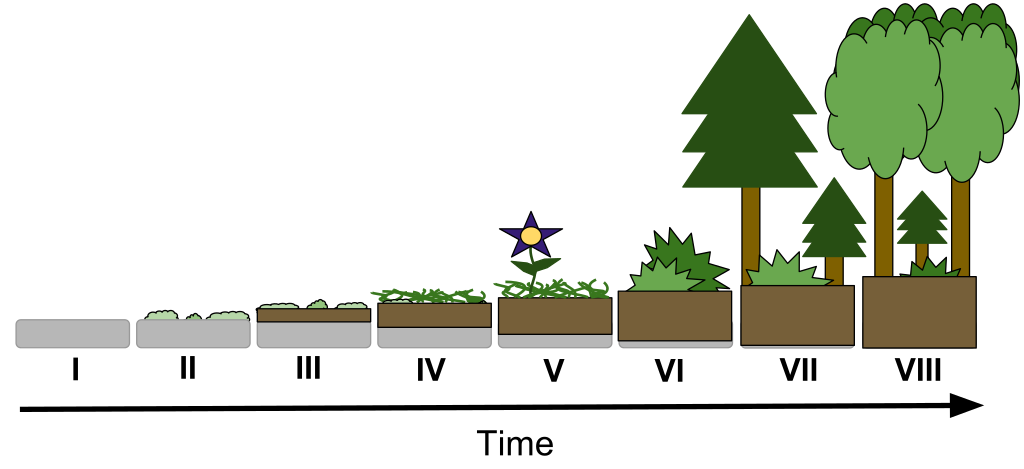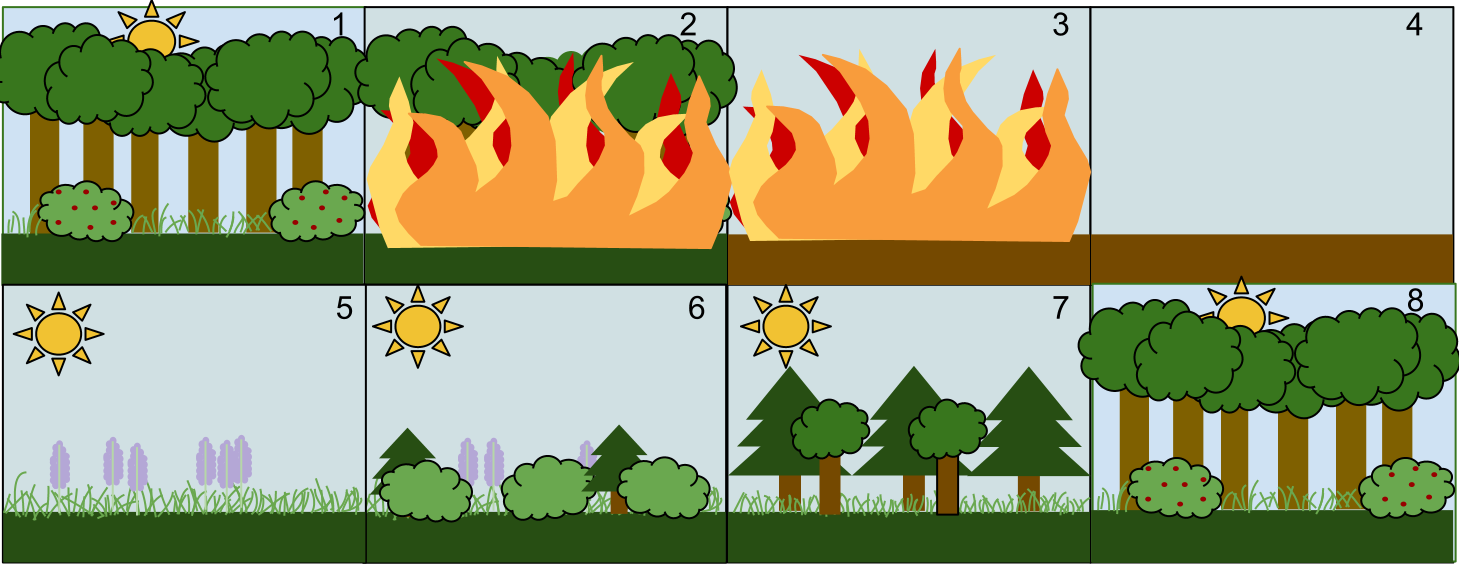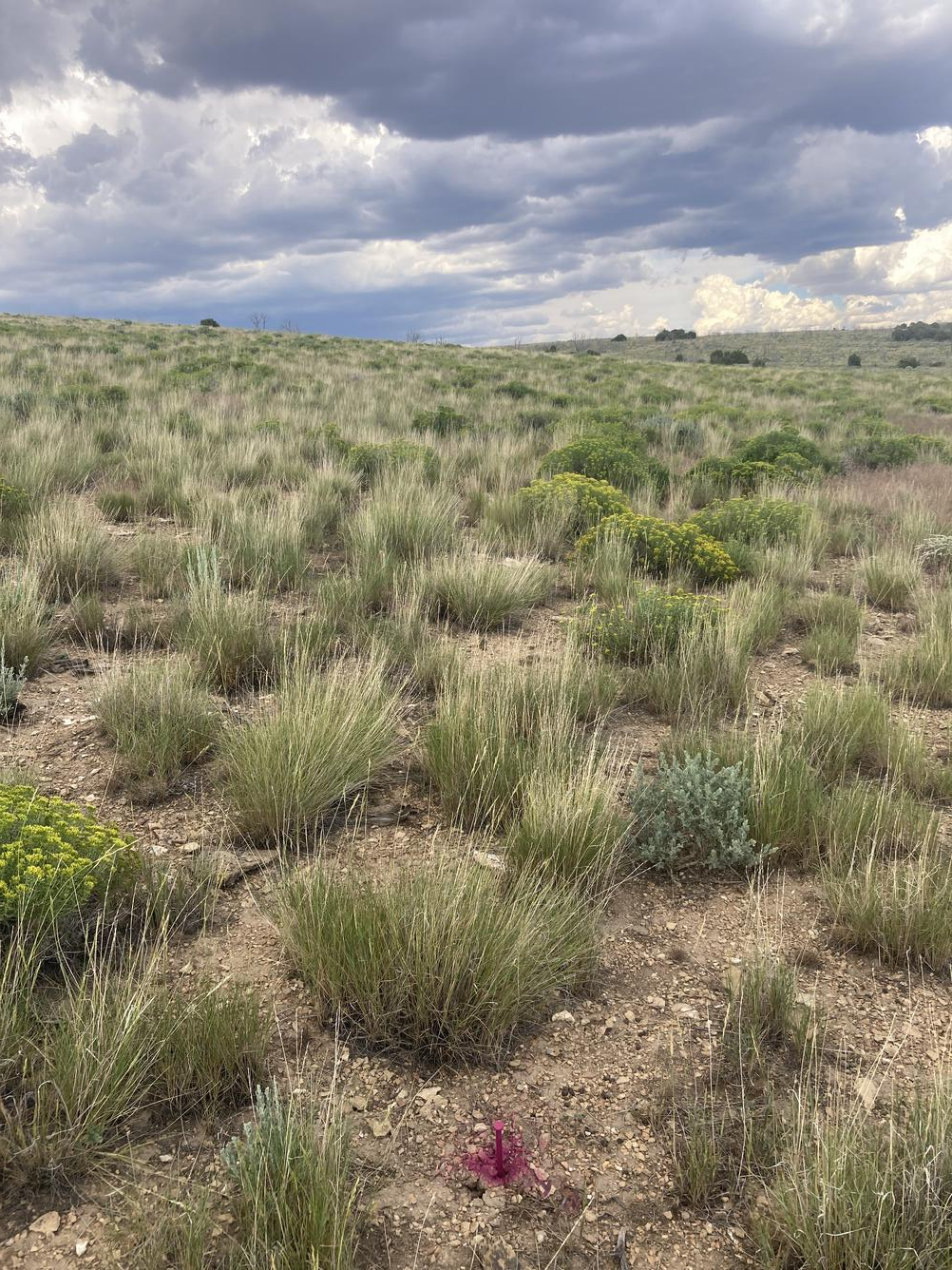IB Syllabus focus:
‘Primary occurs on new substrate without soil (e.g., lava, moraines). Secondary follows disturbance on existing soil (e.g., abandoned fields, post-fire forests). Use well-documented or local examples.’
Primary and secondary succession describe how ecosystems develop and change over time. These processes show how life colonises new substrates or recovers after disturbance.
Primary Succession
Primary succession: The gradual development of ecosystems on newly formed or exposed surfaces that lack soil and prior biological communities.
Primary succession begins when life colonises a new substrate without soil, such as lava flows, glacial moraines, or newly exposed rock faces.

Diagram showing the canonical stages of primary succession from bare rock to a mature community via pioneer lichens/mosses, grasses/herbs, shrubs, and trees. Labels emphasise the role of early colonisers in initiating soil development, enabling later seral stages. Actual species vary by biome and climate. Source.
Pioneer Species
The earliest organisms are known as pioneer species, which play a critical role in initiating ecological development.
Common pioneers include lichens and mosses.
They can survive with minimal nutrients, resist extreme conditions, and begin breaking down rock.
Their biological activity contributes to the gradual formation of soil.
Soil Formation and Progression
Over time:
Weathering of rock and the accumulation of organic matter from dead pioneers create the first thin soils.
As soil depth and fertility increase, new species such as grasses and small shrubs establish.
Eventually, more complex plants such as trees and large shrubs develop, creating habitats for animals.
Characteristics of Primary Succession
Time scale: Slow, often hundreds to thousands of years.
Limiting factors: Lack of soil, water availability, and extreme exposure.
Ecosystem development: Energy flow, nutrient cycling, and species diversity gradually increase.
Secondary Succession
Secondary succession: The re-establishment of ecosystems following a disturbance where soil and some biological legacies remain.
Unlike primary succession, **secondary succession occurs on existing soil, where an ecosystem previously existed but was disturbed.

Numbered stages of secondary succession following a fire: disturbance on intact soil, rapid colonisation by annuals and grasses, establishment of shrubs and young trees, then recovery of a mature forest. The sequence highlights how seed banks, roots, and surviving organisms accelerate recovery. Time scales and species composition vary with ecosystem and disturbance regime. Source.
Speed and Recovery
Secondary succession proceeds more quickly than primary succession because:
Soil is already present, containing nutrients and microbial communities.
Seeds, roots, and dormant organisms often survive within the soil.
Animal populations can recolonise more rapidly.
Because soil, seed banks, and root systems typically remain, secondary succession proceeds much faster than primary succession.

Photograph of a recently burned sagebrush-steppe site where perennial bunchgrasses have re-established without invasion by exotic annuals, illustrating rapid secondary succession on intact soils. Such recovery reflects surviving roots/seed banks and suitable post-fire conditions. The specific site and species will differ by biome and fire severity. Source.
Stages of Secondary Succession
Early stages: Fast-growing species like grasses, herbs, and annual plants colonise quickly.
Intermediate stages: Shrubs and young trees establish, increasing structural diversity.
Later stages: Forests or stable ecosystems reappear, resembling the pre-disturbance community if conditions remain stable.
Characteristics of Secondary Succession
Time scale: Faster than primary succession, sometimes within decades.
Disturbance role: Fire, deforestation, or storms act as initiating events.
Community dynamics: May not always restore the original ecosystem, depending on disturbance severity.
Comparing Primary and Secondary Succession
Key Similarities
Both processes:
Involve sequential changes in community composition.
Show increasing biodiversity and ecosystem stability over time.
Are driven by interactions between abiotic conditions and biotic colonisation.
Key Differences
Starting conditions:
Primary succession starts from bare substrate with no soil.
Secondary succession begins with soil already present.
Time scale:
Primary succession is much slower.
Secondary succession is faster due to existing resources.
Examples:
Primary: Lava fields in Iceland, post-glacial landscapes.
Secondary: Post-wildfire regeneration in Mediterranean forests, abandoned farmland returning to grassland.
The Role of Disturbance and Stability
Disturbances such as fire, flooding, or volcanic eruptions are central to initiating succession. Their intensity determines whether recovery follows a secondary pathway (soil intact) or a primary pathway (soil absent). These processes illustrate ecosystem resilience and adaptation to environmental change.
FAQ
Pioneer species modify the environment in ways that make it more habitable for other organisms. Their growth helps trap dust and organic matter, which contributes to soil development.
Additionally, they retain moisture, reduce surface erosion, and create microhabitats. This facilitates the establishment of plants requiring more stable substrates, leading to increased diversity.
Secondary succession benefits from pre-existing biological legacies.
Soil remains intact, often containing nutrients, microbes, and seed banks.
Roots and underground structures may survive and resprout.
Animals recolonise more quickly as shelter and food return faster.
This head start shortens the timescale, allowing recovery within decades rather than centuries.
Human actions can accelerate or slow natural processes.
Accelerate: Reforestation projects, soil amendments, or re-seeding can speed up succession.
Slow: Deforestation, overgrazing, and pollution may prevent communities from progressing beyond early stages.
Intervention often determines whether ecosystems move towards recovery or remain degraded.
Climax communities depend on:
Regional climate (temperature, rainfall patterns).
Soil type and nutrient availability.
Disturbance frequency and intensity.
Species interactions such as competition or facilitation.
Thus, the “end point” of succession varies between ecosystems and is not uniform worldwide.
Yes, succession does not always result in one predictable climax community.
Disturbances at key stages can shift the trajectory, producing different outcomes.
For example, grazing pressure might maintain grasslands instead of allowing woodland formation.
These alternative stable states highlight the complexity and variability of ecological succession.
Practice Questions
Question 1 (2 marks)
Define primary succession and give one example of where it may occur.
Mark scheme:
Definition of primary succession: gradual development of ecosystems on newly exposed surfaces with no pre-existing soil or life (1 mark).
Example: e.g., lava flows, glacial moraines, or newly exposed rock faces (1 mark).
Question 2 (5 marks)
Compare and contrast primary and secondary succession, highlighting differences in starting conditions, speed of development, and examples of each.
Mark scheme:
Primary succession begins on bare substrate without soil, while secondary succession begins where soil already exists (1 mark).
Primary succession is slow, taking hundreds to thousands of years, while secondary is faster, occurring over decades (1 mark).
Examples: primary – lava fields, post-glacial landscapes (1 mark); secondary – abandoned farmland, post-wildfire forest regeneration (1 mark).
Any valid point of similarity (e.g., both involve seral stages, increasing biodiversity and ecosystem stability over time) (1 mark).

